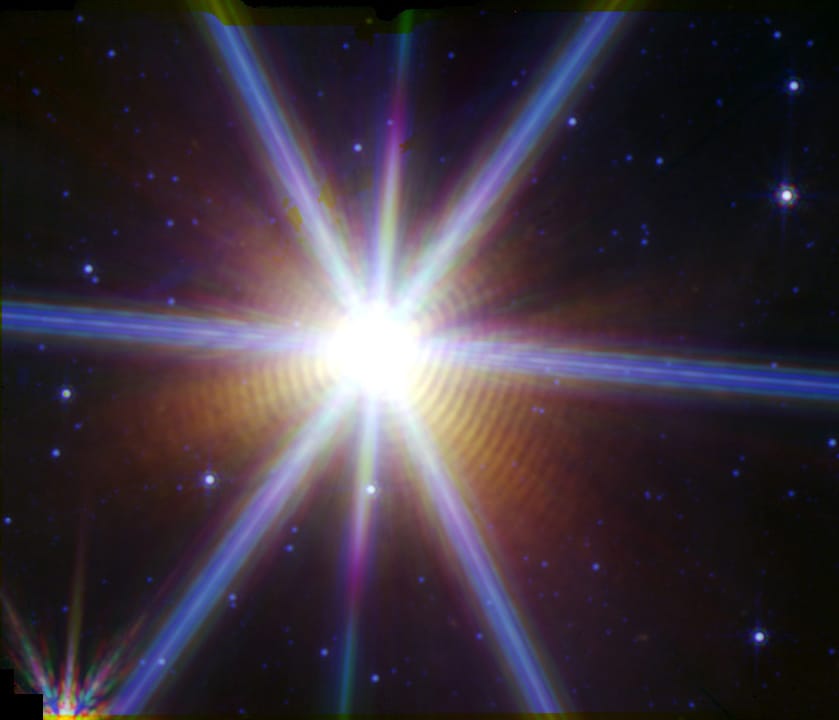- Bad Astronomy Newsletter
- Posts
- NASA declaration against Trump’s science attacks, more dusty WR star spirals
NASA declaration against Trump’s science attacks, more dusty WR star spirals
The Voyager Declaration takes a stand against budget cuts, and a gorgeous JWST image of Wolf-Rayet star dust expulsion

The Trifid Nebula and environs. Credit: RubinObs/NOIRLab/SLAC/NSF/DOE/AURA
July 22, 2025 Issue #908
NASA employees sign Voyager Declaration protesting attacks on NASA
Hundreds of signatories include astronauts, scientists
287 NASA workers have made an open declaration against the attacks on the beloved space agency by the Trump administration.
Called the Voyager Declaration, it’s directed to interim NASA Administrator Sean Duffy, who took over the agency a few weeks ago. I would be remiss not to note that he has zero experience running an agency like this, has no specific scientific knowledge, and is a Trump loyalist.
That he was put in charge by Trump is yet another slap in the face to NASA, which has suffered mightily under Trump’s chaotic rule. The White House recently released a budget that has been fairly called an extinction level event for NASA, cutting a quarter of its budget overall and nearly half of the science budget.
Yet another galling part of this is that the White House budget is a request, not a fiat. Congress has to approve it, and in fact it looks like the House may be willing to fight Trump on these cuts. Still, Goddard Space Flight Center, where I used to work on Hubble, is looking to reduce half off its staff. Half.
These attacks by Trump and his regime have been aimed at many departments and agencies, and science has taken a huge hit. The National Institutes of Health and the EPA both had employees put up their own open letters of protest — not without risk, and, true to form, Trump’s pick to run the EPA, Lee Zeldin, put those employees on administrative leave.
But these scientists felt it was worth the risk to make the declarations, because these attacks are nothing short of fascism. You can read more about this at the New York Times (gift link) and CNN.
The NASA Voyager Declaration covers a lot of ground, including threats to mission safety, mission funding, staff reductions, international participation, and more. This declaration and the others are important statements against what’s happening government — and nation — wide.
The NASA declaration is open for public signatures, too. I signed it, and I hope you do as well.
These declarations are supported and hosted by the terrific folks at Stand Up For Science, who organized a big rally in DC a few months ago and have been busy working on other ways to protect these attacks on science. I’m happy and proud to support them in this cause, and urge you to take a look at what they do and support them as well. These are scary and uncertain times, and the best things we can do are take action and make our voices heard. Stand Up For Science is fantastic outlet for that.
And now, a unicorn chaser:
Another staggering image from JWST of dusty spirals
More dust shells seen around powerful Wolf Rayet stars
One of my very first articles for Scientific American was about WR140, a binary system made up of two massive and ridiculously luminous stars (these kinds of stars are called Wolf-Rayet stars, hence the WR). Both blast out fierce stellar winds of various subatomic particles and even whole elemental nuclei like carbon. Every 8 years they swing past each other on their elliptical orbits, and the winds crash into each other. The physics (and geometry!) is complex, but this winds up sending out thin shells of cosmic dust that expand away from the pair at high speed. After several orbits, we see what looks like a rippling spiral emanating from WR140. It’s beautiful and bizarre and a little bit terrifying, given the velocities, masses, and energies involved.
We’ve seen other systems that do something similar like emit simpler spirals, or complicated spirograph-like arms, such as from WR104 and Apep. But are there any others that send out cascading multiple shells like WR140?
Yes! JWST observations of four other Wolf-Rayet binary systems showed similar shells surrounding them [link to journal paper]. I somehow missed this in the onslaught of press releases I get, but happily artist Cheryl Blanchard took the images of WR112 from the study, processed them, and put the result up on Bluesky. It’s beautiful:

WR112 and its dust shells. Credit: NASA/ESA/CSA, processed by Cheryl Blanchard
Whoa. I count 18 shells at least, with more lost in the glare of the two stars in the center.

Subscribe to Premium to read the rest.
Become a paying subscriber of Premium to get access to this post and other subscriber-only content.
Already a paying subscriber? Sign In.
A subscription gets you:
- • Three (3!) issues per week, not just one
- • Full access to the BAN archives
- • Leave comment on articles (ask questions, talk to other subscribers, etc.)

Reply